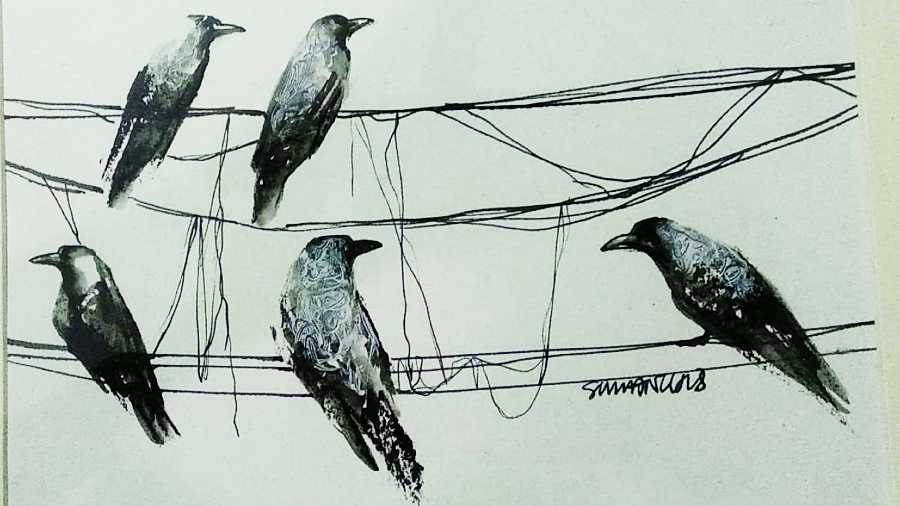A grandaunt returned after a half-year trip to Boston in the US and complained thereafter, “Would you believe it, I didn’t see a single crow all these months?”
I am not one to harbour any love for the kak or Indian common crow. But once she said it, I realised that the bird is indeed an indelible part of my daily life, if only to just shoo away.
“Biophilia,” remarks Silanjan Bhattacharyya when I tell him about the Boston repartee. Bhattacharyya is professor of zoology at the West Bengal State University. He is an evolutionary biologist and has research papers on the common crow or Corvus splendens.
I look up “biophilia”; it means an innate tendency of human beings to seek a connection with nature. Bhattacharyya means to say my elderly relation’s feeling of disconnectedness with the US cityscape was enforced by the absence of the Indian crow among other familiar things.
When Mark Twain wrote, “In the course of his evolutionary promotions, his sublime march toward ultimate perfection, he has been a gambler, a low comedian, a dissolute priest, a fussy woman, a blackguard…,” he was eulogising the Indian crow.
It is Bhattacharyya who nudges me to explore Twain’s observations on our crow in his book Follow the Equator. He explains, “The crow is known as the feathered ape because of its intelligence… Intelligent is a term that is loosely used, but in scientific terms it connotes cognitive power. The crow has exemplary cognitive power.” And that is unusual because humans and primates have a well-developed neocortex — part of the brain — and birds do not.
According to Bhattacharyya, there has been a good amount of research on the topic, albeit abroad, the last 15 to 20 years. “In India such topics don’t get the deserved encouragement or funding,” he adds.
But humans and crows have lived in close proximity for years and given this intertwined living, there exists even among the non-science community a half-realisation of the crow’s superior intelligence.
Exactly a hundred years ago, the Bengali genius poet and writer Sukumar Ray created the “crow-acters” of Sri Kakeshwar Kuchkuche and Drighangchoo. Kakeshwar is quite the equivocator and Drighangchoo’s ominous cawing is enough to furrow the brows of the king of the land and by association his entire cabinet. And then of course, there are all those Hindi songs. Be it Jhoot bole kauwa kaate or Kauwa chala hans ki chaal or the Jhoom jhoom kauwa bhi dholak bajae number wherein Kishore Kumar is seen flapping with gusto, each is actually a nod to the crow’s mental prowess and no paean about prejudice.
In India there are three or four varieties of crows. There is the urban variety with its ashen head and there is the sylvan variety, which is slightly bigger. Many people feed crows — not so much to mitigate the black bird’s hunger as their own real and imagined sins. It has been observed that instead of eating up those pieces of ruti (flat bread) or the muri (puffed rice), some birds stow away a good portion. “This is called caching,” says Bhattacharyya.
He continues, “They also plug the hole or crevice that is their storage space with a rag or a pebble. But some crows don’t participate in the food rush. These observe from a distance and when the others have cached and plugged and gone their way, they raid those secret reserves.”
According to him, it has been observed that some crows even avenge this
pilfering by caching pebbles or stone chips — obviously to trick their thieving brethren.
Bhattacharyya has been interested in the crow since he was a boy. He narrates an incident from the time he was eight — he is 60 now. “There was a coconut tree adjoining my grandparents’ house. Some crows would nest in it and routinely drop fish bones and whatnot onto our courtyard. After my grandmother’s complaints, my chhotomama (uncle) broke the nest.”
As Bhattacharyya remembers it, not only did the birds attack his uncle that day, but thereafter whenever he stepped out they would swoop down and peck him. “Eventually, he shaved his head to confuse the birds. It worked for a day or two but not beyond that.” Today, there is enough research to prove that crows can remember faces. They can also “culturally transmit” any information they want to get around.
The urban Indian crow has other quirks. Bhattacharyya recounts, “After 2pm they get together and bathe. And if you observe them, you will notice that there is a distinct hierarchy. Then, every evening before returning to their nests, they congregate at a vantage point and have a meeting. They are punctual. My wife used to feed some crows at a certain time, but whenever she defaulted they would caw.”
The last reminds me of Kamim, who manned the tea machine in office; he would lay out a feast of biscuits at lunch time on the balcony ledge for a scraggly looking crow with a broken beak. After Kamim quit, I never saw it again.
“The crow has more than one distinct call,” says Bhattacharyya. The American ornithologist Pamela Cecile Rasmussen had identified 11 crow calls.
Those who observe crows have a definite anthropomorphic idea as to what they are trying to say. Twain also wrote, “If I sat on one end of the balcony, the crows would gather on the railing at the other end and talk about me… my complexion, and probable character and vocation and politics, and how I came to be in India…”
Some scientists even claim crows have a sense of humour. I don’t know about that, but I remember reading somewhere about Charlie Chaplin’s daughter Victoria’s pet white crow. When it went missing, Chaplin told reporters he was confident his daughter would spot it anywhere.
He said, “You see, her crow smiled.”










